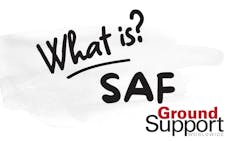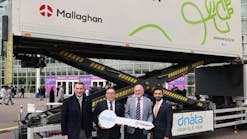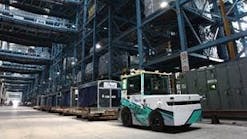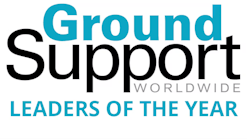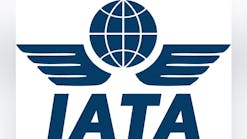As the aviation industry sets its sights on achieving net-zero carbon emissions by 2050, more efforts are being made to make air travel environmentally friendly.
Sustainable aviation fuel (SAF) is playing a key role in this goal.
“SAF provides a reduced carbon footprint while adhering to the strict requirements that all aviation fuel must meet as laid out in the ASTM International (ASTM) D7566 standard,” explain Gevo officials in its Sustainable Aviation Fuel whitepaper.
“The development of sustainable aviation fuel (SAF) will allow the use of existing aircraft, including long-range models, but with a substantial collective reduction of greenhouse gas (GHG) emissions,” Gevo officials added.
“The product addresses the root cause of aviation’s climate problem – the burning of fossil fuels,” Chris Cooper, vice president of North America – renewable aviation at Neste, explained on the AviationPros Podcast. “SAF is a direct replacement for fossil Jet A that emits up to 80 percent less carbon dioxide in the lifecycle basis.
“It significantly reduces the pollution.”
A key factor behind the industry’s push for SAF adoption is that the product is a drop-in replacement for conventional jet fuel.
On the AviationPros Podcast, Cooper noted SAF is molecularly the same as Jet A fuel. The synthetic jet fuel meets all original equipment manufacturer (OEM) and American Society for Testing and Materials (ASTM) specifications for jet fuel.
“SAF is a drop-in solution,” he said. “As an industry, we’ve got over 100 years in developing the pipeline systems, the airport storage facilities, and SAF is able to be dropped in or used directly on top of or mixed in with conventional jet fuel.
“That eliminates any airport and/or infrastructure investment to sustain the development and expansion of SAF into our marketplace,” Cooper added.
SAF can be created with various feedstocks, including used cooking oils.
“Rather than crude oil, we actually use fats, oils, greases (and) waste residues to manufacture our products,” Cooper said.
Blending SAF
Sustainable aviation fuel is in use across the aviation industry. However, at this time, there are ratio limits to how much SAF can be utilized, Pratik Chandhoke, technical services manager SAF at Neste, explained in Ground Support Worldwide.
“Regulations require that sustainable aviation fuel is blended with fossil jet fuel, up to a 50-50 ratio. The blending ratio will ultimately determine the actual emissions reductions realized. Once blended, the fuel meets ASTM specifications,” Chandhoke said.
“The blending requirement ensures that sustainable aviation fuel works safely with older aircraft engines,” he continued. “However, the aviation industry is researching how sustainable aviation fuel can be used in its pure form to power aircraft in the future.”
In 2023, Virgin Atlantic flew the first commercial trans-Atlantic flight powered by 100 percent SAF.
The flight took off from London Heathrow (LTH) and traveled to New York’s John F. Kennedy Airport (JFK).
“Flight100 proves that sustainable aviation fuel can be used as a safe, drop-in replacement for fossil-derived jet fuel and it’s the only viable solution for decarbonizing long haul aviation. It’s taken radical collaboration to get here and we’re proud to have reached this important milestone, but we need to push further. There’s simply not enough SAF and it’s clear that in order to reach production at scale, we need to see significantly more investment. This will only happen when regulatory certainty and price support mechanisms, backed by government, are in place. Flight100 proves that if you make it, we’ll fly it,” Shai Weiss, chief executive officer at Virgin Atlantic said in a press release announcing the flight.
Hurdles and Solutions for Adopting SAF
To scale up production and increase supply, blending mandates and other regulatory measures are required, Andreea Moyes, Air BP’s global head of sustainability, wrote for AviationPros.
The measures should include incentives to bridge the gap with conventional jet fuel, she advised.
“Blending mandates as a way of stimulating demand are welcomed, however Air BP is calling for the complexities of SAF supply and delivery to be factored in when implementing these mandates,” Moyes said.
“The SAF supply chain faces a ‘chicken and egg’ problem with supply and demand: costs will come down if production scales up, but fuel providers are lacking a consistent demand signal to increase production and demand is low due to the high price premium,” Ashleigh McDougall, head of Europe and South Africa at Shell Aviation, explained in a Q&A interview with AviationPros.
McDougall added that Shell Aviation officials believe government and industry mandates are essential and can help encourage SAF adoption.
“Mandates should ideally be aligned globally, technology agnostic, be ambitious but consistent with pace to build supply capabilities and infrastructure and increase over time as production scales up,” McDougall said. “Once mandates are in place as a foundation, we can begin to add the other measures to complement them, such as fiscal incentives.”
According to the International Air Transport Association (IATA), SAF volumes in 2023 reached over 600 million liters, double the amount produced in 2022.
IATA also reported that SAF accounted for 3 percent of all renewable fuels produced, with 97 percent of renewable fuel production going to other sectors.
In 2024, IATA estimated SAF production is expected to triple to 1.875 billion liters, accounting for 0.53 percent of aviation’s fuel need, and 6 percent of renewable fuel capacity.
“The small percentage of SAF output as a proportion of overall renewable fuel is primarily due to the new capacity coming online in 2023 being allocated to other renewable fuels,” IATA officials explained.
“The doubling of SAF production in 2023 was encouraging as is the expected tripling of production expected in 2024. But even with that impressive growth, SAF as a portion of all renewable fuel production will only grow from 3 percent this year to 6 percent in 2024,” said IATA director general Willie Walsh. “This allocation limits SAF supply and keeps prices high.
“Aviation needs between 25 percent and 30 percent of renewable fuel production capacity for SAF. At those levels aviation will be on the trajectory needed to reach net zero carbon emissions by 2050. Until such levels are reached, we will continue missing huge opportunities to advance aviation’s decarbonization,” Walsh continued. “It is government policy that will make the difference. Governments must prioritize policies to incentivize the scaling-up of SAF production and to diversify feedstocks with those available locally.”
Tax Incentives
Among its objectives, the Inflation Reduction Act that President Joe Biden signed into law in 2022 aims to reduce greenhouse gas emissions produced in the United States.
The $430 billion bill, also known as H.R. 5376, intends to promote clean energy and includes five years of dedicated SAF tax provisions intended to encourage the production of the renewable fuel.
When the bill was signed, the National Air Transportation Association (NATA) released a statement noting that the organization has advocated for creation of a dedicated SAF Blender’s Tax Credit to stimulate investment in the nascent industry and provide economic parity with other renewable fuels.
“The sustainability measures included in the Inflation Reduction Act of 2022 represent a critical breakthrough in the business aviation industry’s goal to achieve net-zero carbon emissions by the year 2050,” Karen Huggard, vice president of government affairs at NATA, said in the statement after the bill’s passage.
The SAF Blender’s Tax Credit and Clean Fuel Production Credit that Biden signed into law represent a five-year down payment on the policies necessary to scale up SAF production in line with industry demand, Karen Huggard, vice president of government affairs at NATA, said in a statement after the bill’s passage.
The National Business Aviation Association (NBAA) noted in a statement that as of Jan. 1, 2023, a $1.25 per gallon credit will be available for each gallon of SAF sold as part of a qualified fuel mixture with a demonstrated lifecycle greenhouse gas (GHG) reduction of at least 50 percent compared to conventional jet fuel. The stand-alone SAF tax credit increases by 1 cent for each percentage point by which the lifecycle GHG emissions reduction of such fuel exceeds 50 percent, up to $1.75 per gallon.
“NBAA has long advocated for this blender's tax credit as a vital step in fulfilling our industry’s pledge to achieve net-zero CO2 emissions by 2050 under the Business Aviation Commitment on Climate Change,” Ed Bolen, NBAA president and CEO, said when the bill was passed. “Implementation of this credit marks genuine progress toward increasing SAF production, promoting greater availability at general aviation airports and reducing costs to end users.”
